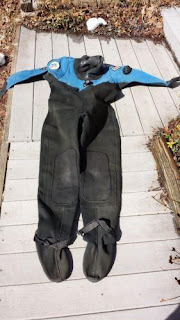Rubber Wet/ Dry Suits
Introduction
- A dry suit or wet suit provides the wearer with environmental protection by way of thermal insulation and exclusion of water,and is worn by divers, boaters, water sports enthusiasts, and others who work or play in or near cold or contaminated water.
Rubber Wet Suit
- A rubber wet suit is generally made of foamed neoprene rubber which is worn by water sports persons like surfers, divers, windsurfers, canoeists etc. Accordingly, they are known as rubber swim suit, rubber surf suit, rubber diving suit and so on.
- This type of rubber suit provides thermal insulation, abrasion resistance and buoyancy. The insulation properties are dependent upon bubbles of gas enclosed within, which reduce its ability to conduct heat.
· Rubber Dry Suit-
- A rubber dry suit has more or less the same functions as those of wet suits. It also provides thermal insulation to the wearer in water and is used by divers, boaters, and other water sports persons. However there are certain differences between dry suit and wet suit.
- Dry suits prevent water to be entered into the rubber suit. This leads to better insulation in dry suits making them more suitable for cold water usage. However, dry suits can be very hot in warm or hot air.
The manufacturing process for both types the wet
and dry scuba suits is similar. Both are constructed in assembly-line fashion
The process of making wet suit is described below
The process of making wet suit is described below
- The neoprene latex is mixed with the additives in the industrial mixer
- The neoprene latex is vulcanized or heated to a height of two feet and it is allowed to cool.
- The cooled rubber is run through a slicing machine, which cuts the large mass lengthwise. The slicing mechanism is set to a specified thickness, typically 0.12, 0.24, or 0.28 in (3, 6, or 7 mm). (Divers wear wet suits of different thicknesses, depending on the type of water they are diving in.)
- The sheets of rubber, each about the size of a sheet of plywood, are then placed on a conveyor belt where they are lifted and sprayed with glue.
- The sheets of rubber are laminated with a form of nylon that is squeezed onto the rubber. The laminated nylon is then allowed to dry. Once dry, the nylon-bonded rubber becomes stretchy. The rubber is inspected depends on their size and thickness
- The sorted rubber is loaded onto a palette and sent to the wet suit makers.
- The wet suit maker stretches a stack of rubber about 10-15 sheets high and lays a pattern over the top.
- The pattern is traced with a white crayon.A sawing machine cuts suit panels out of the stacks of rubber, following the crayoned-on pattern. Dry suits are hand-cut.
- The suit panels are sent to the decal department, where decals are adhered using a heat press. The panels are sent to the zipper department where zippers, pockets, kneepads, and flatwork are sewn or pressed on.
- The panels are then sent to the coating department, where each panel is coated with neoprene cement. The open sides of the front and back panels are glued together and arms and legs are attached to the body of the suit.
- The suits are sent to the final sewing area, where nylon thread is used to stitch the seams of the suit. The suit is cleaned and inspected for quality and tags are adhered using stiching or a hot press.




Comments
Post a Comment